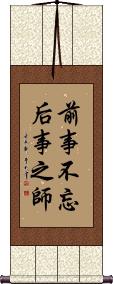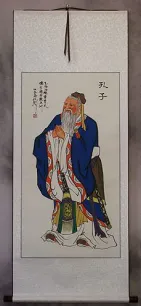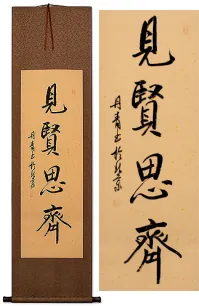Many custom options...
And formats...

Not what you want?
Try other similar-meaning words, fewer words, or just one word.
Feel free to email me with your request. If it's easy, I'll translate it for free and add it to this database of calligraphy for you.
Head Teacher in Chinese / Japanese...
Buy a Head Teacher calligraphy wall scroll here!
Past experience is the teacher for the future
Past events not forgotten serve as teachers for later events.
The most literal translation to English of this ancient 前事不忘后事之师 Chinese proverb is:
“Past events not forgotten serve as teachers for later events.”
However, it's been translated several ways:
Don't forget past events, they can guide you in the future.
Benefit from past experience.
Past experience, if not forgotten, is a guide for the future.
Past calamity is my teacher.
A good memory for the past is a teacher for the future.
The remembrance of the past is the teacher of the future.
If one remembers the lessons of the past; They will serve as a guide to avoid mistakes in the future.
The origin:
This proverb comes from the 5th century B.C., just before the Warring States Period in the territory now known as China.
The head of the State of Jin, Zhi Bo, seized power in a coup. He did this with help from the armies of the State of Han and Wei. Instead of being grateful for the help from Han and Wei, he treacherously took the land of Han and Wei. Never satisfied, Zhi Bo employed the armies of Han and Wei to attack and seize the State of Zhao.
The king of Zhao took advice from his minister Zhang Mengtan and secretly contacted the Han and Wei armies to reverse their plans and attack the army of Zhi Bo instead. The plan was successful, and the State of Zhao was not only saved but was set to become a powerful kingdom in the region.
Zhang Mengtan immediately submitted his resignation to a confused king of Zhao. When asked why, Zhang Mengtan said, “I've done my duty to save my kingdom, but looking back at past experience, I know sovereign kings are never satisfied with the power or land at hand. They will join others and fight for more power and more land. I must learn from past experiences, as those experiences are the teachers of future events.”
The king could not dispute the logic in that statement and accepted Zhang Mengtan's resignation.
For generations, the State of Zhao continued to fight for power and land until finally defeated and decimated by the State of Qin (which led to the birth of the Qin Dynasty in 221 B.C.).
This in-stock artwork might be what you are looking for, and ships right away...
Gallery Price: $72.00
Your Price: $39.88
Gallery Price: $61.00
Your Price: $33.88
Gallery Price: $61.00
Your Price: $33.88
Gallery Price: $61.00
Your Price: $33.88
Gallery Price: $61.00
Your Price: $33.88
Gallery Price: $61.00
Your Price: $33.88
Gallery Price: $90.00
Your Price: $49.88
Gallery Price: $90.00
Your Price: $49.88
Gallery Price: $90.00
Your Price: $49.88
Gallery Price: $100.00
Your Price: $49.88
Not the results for head teacher that you were looking for?
Below are some entries from our dictionary that may match your head teacher search...
| Characters If shown, 2nd row is Simp. Chinese |
Pronunciation Romanization |
Simple Dictionary Definition |
三尊 see styles |
sān zūn san1 zun1 san tsun sanzon; sanson さんぞん; さんそん |
(1) (さんぞん only) {Buddh} Buddha triad; image of a Buddha attended by two Bodhisattvas; (2) (さんぞん only) {Buddh} (See 三宝) The Three Jewels; Buddha, the teachings of Buddha, and the community of monks and nuns; (3) (さんぞん only) (See 三尊天井) head and shoulders (stock price, etc. chart pattern); (4) the three people one must esteem: master, father, teacher The three honoured ones: Buddha, the Law, the Ecclesia or Order. Others are: Amitābha, Avalokiteśvara, and Mahāsthāmaprāpta, who, according to the Pure-land sect, come to welcome the dying invoker. Another group is Bhaiṣajya, Vairocana, and Candraprabha; and another, Śākyamunī, Mañjuśrī, and Samantabhadra. |
周羅 周罗 see styles |
zhōu luó zhou1 luo2 chou lo shūra |
(周羅髮); 首羅 cūḍā; a topknot left on the head of an ordinand when he receives the commandments; the locks are later taken off by his teacher as a sign of his complete devotion. |
和上 see styles |
hé shàng he2 shang4 ho shang wajou / wajo わじょう |
(1) (honorific or respectful language) preceptor or high priest (in Shingon, Hosso, Ritsu or Shin Buddhism); (2) second highest priestly rank in Buddhism; (3) master (of one's art, trade, etc.); (1) (honorific or respectful language) preceptor or high priest (in Tendai or Kegon Buddhism); (2) second highest priestly rank in Buddhism; (3) monk (esp. the head monk of a temple); (4) master (of one's art, trade, etc.); (place-name) Wajō a senior monk (a teacher-monk) who has the authority to administer the precepts |
和尚 see styles |
hé shang he2 shang5 ho shang wajou / wajo わじょう |
Buddhist monk (1) (honorific or respectful language) preceptor or high priest (in Shingon, Hosso, Ritsu or Shin Buddhism); (2) second highest priestly rank in Buddhism; (3) master (of one's art, trade, etc.); (1) (honorific or respectful language) preceptor or high priest (in Tendai or Kegon Buddhism); (2) second highest priestly rank in Buddhism; (3) monk (esp. the head monk of a temple); (4) master (of one's art, trade, etc.); (1) (honorific or respectful language) preceptor or high priest (esp. in Zen or Pure Land Buddhism); (2) second highest priestly rank in Buddhism; (3) monk (esp. the head monk of a temple); (4) master (of one's art, trade, etc.); (personal name) Wajō A general term for a monk. It is said to be derived from Khotan in the form of 和闍 or 和社 (or 烏社) which might be a translit. of vandya (Tibetan and Khotani ban-de), 'reverend.' Later it took the form of 和尚 or 和上. The 律宗 use 和上, others generally 和尚. The Sanskrit term used in its interpretation is 鳥波陀耶 upādhyāya, a 'sub-teacher' of the Vedas, inferior to an ācārya; this is intp. as 力生 strong in producing (knowledge), or in begetting strength in his disciples; also by 知有罪知無罪 a discerner of sin from not-sin, or the sinful from the not-sinful. It has been used as a synonym for 法師 a teacher of doctrine, in distinction from 律師 a teacher of the vinaya, also from 禪師 a teacher of the Intuitive school. |
教頭 教头 see styles |
jiào tóu jiao4 tou2 chiao t`ou chiao tou kyoutou / kyoto きょうとう |
sporting coach; military drill master (in Song times) deputy head teacher; vice principal |
校長 校长 see styles |
xiào zhǎng xiao4 zhang3 hsiao chang kouchou / kocho こうちょう |
(college, university) president; headmaster; CL:個|个[ge4],位[wei4],名[ming2] principal; head teacher; headmaster; headmistress |
灌頂 灌顶 see styles |
guàn dǐng guan4 ding3 kuan ting kanjou; kanchou / kanjo; kancho かんじょう; かんちょう |
(1) {Buddh} baptism-like ceremony performed by the buddhas on a bodhisattva who attains buddhahood; (2) {Buddh} baptism-like ceremony for conferring onto someone precepts, a mystic teaching, etc. (in esoteric Buddhism); (3) {Buddh} pouring water onto a gravestone; (4) teaching esoteric techniques, compositions, etc. (in Japanese poetry or music) abhiṣecana; mūrdhābhiṣikta; inauguration or consecration by sprinkling, or pouring water on the head; an Indian custom on the investiture of a king, whose head was baptized with water from the four seas and from the rivers in his domain; in China it is administered as a Buddhist rite chiefly to high personages, and for ordination purposes. Amongst the esoterics it is a rite especially administered to their disciples; and they have several categories of baptism, e.g. that of ordinary disciples, of teacher, or preacher, of leader, of office-bearer; also for special causes such as relief from calamity, preparation for the next life, etc. |
八思巴 see styles |
bā sī bā ba1 si1 ba1 pa ssu pa Hasshiha |
Also 發思巴 Bashpa, Phagspa, Baghcheba, Blo-gros-rgyal-mtshah, Chos-rgyal-ḥphags-pa. A śramaṇa of Tibet, teacher and confidential adviser of Kublai Khan, who appointed him head of the Buddhist church of Tibet A.D. 1260. He is the author of a manual of Buddhist terminology彰所知論 and translated another work into Chinese. In A.D. 1269 he constructed an alphabet for the Mongol language, "adapted from the Tibetan and written vertically," and a syllabary borrowed from Tibetan, known by the name of Hkhor-yig, for which, however, the Lama Chos-kyi-hod-zer 1307-1311 substituted another alphabet based on that of Śākya-paṇḍita. |
学年主任 see styles |
gakunenshunin がくねんしゅにん |
head of year; teacher in charge of all classes for a whole year |
Variations: |
oshou(和尚)(p); kashou; wajou / osho(和尚)(p); kasho; wajo おしょう(和尚)(P); かしょう; わじょう |
(1) (honorific or respectful language) {Buddh} (trad. pronounced おしょう in Zen and Pure Land, かしょう in Tendai and Kegon, わじょう in Shingon, Hosso, Ritsu and Shin Buddhism) priestly teacher; preceptor; (2) (おしょう, かしょう only) {Buddh} monk (esp. the head monk of a temple); priest; head priest; (3) {Buddh} (See 法眼・2) second highest priestly rank in Buddhism; (4) master (of one's art, trade, etc.) |
The following table may be helpful for those studying Chinese or Japanese...
| Title | Characters | Romaji (Romanized Japanese) | Various forms of Romanized Chinese | |
| Past experience is the teacher for the future | 前事不忘后事之師 前事不忘后事之师 | qián shì bú wàng hòu shí zhī shī qian2 shi4 bu2 wang4 hou4 shi2 zhi1 shi1 qian shi bu wang hou shi zhi shi | ch`ien shih pu wang hou shih chih shih chien shih pu wang hou shih chih shih |
|
| In some entries above you will see that characters have different versions above and below a line. In these cases, the characters above the line are Traditional Chinese, while the ones below are Simplified Chinese. | ||||
Successful Chinese Character and Japanese Kanji calligraphy searches within the last few hours...















